

Employment Law
Jul 07, 2014
80 likes | 681 Views
Employment Law. Objective 3.01 Understand employment law. Employment Law Basics. Employment law Division of law that governs the relationship between employers and employees Employment law stems from various forms of law including tort, criminal, contract, and labor law.
Share Presentation
- fair employment practice
- disparate impact
- federal act
- medical conditions
- fair labor standards act

Presentation Transcript
- Employment Law Basics Employment law Division of law that governs the relationship between employers and employees Employment law stems from various forms of law including tort, criminal, contract, and labor law
- Employment Law Basics Employer Person or company who pays a person for a wage, salary, payment or fee in exchange for supervising and controlling the employee’s activities
- Employment Law Basics Employee Person who works for an employer for a wage, salary, payment or fee, guided by an express or implied agreement The employee is under the control and supervision of the employer
- Employment Law Basics Independent contractor Person who works for an employer for a wage, salary, payment or fee, guided by an express or implied agreement Person is not subject to the control or supervision of an employer
- Employment Law Basics Express employment agreement A formal contract, either oral or written, that specifically states the terms and conditions of employment
- Employment Law Basics Implied employment agreement An employment contract in which the terms and conditions may be inferred through the actions, comments, promises, and employment practices of either the employer or employee.
- NC Department of Labor Promotes the general well-being, safety, and health of NC workers by: Enforcing occupational and health standards Setting the minimum wage and maximum number of work hours per week Providing apprentice programs for the skilled trades Conducting inspections for mines, boilers, elevators, amusement rides, and quarries
- Fair Labor Standards Act Also referred to as the Wage and Hour Act Federal law that sets the minimum wage, overtime pay, and age requirements for certain types of employees This act does not apply to the minimum wage or overtime pay of professional workers, executives, administrative, and outside sales employees
- Fair Labor Standards Act North Carolina Youth Employment Provisions of the Wage and Hour Act for Nonagricultural Occupations Law that establishes labor standards and labor guidelines for youth 17 years old and younger In general, children of any age are permitted to work for business owned by parents
- Occupational Safety & Health Act Federal act that establishes and promotes workplace safety standards for businesses Employers should undertake specific precautions to ensure that the workplace is free of hazards that would lead to harm, permanent injury or death Violators may be fined up to $7,000 per day
- Americans with Disability Act Federal act that prohibits discrimination based on a person’s disability if the person with the disability is able to perform the essential functions of the job requirements
- Age Discrimination Act in Employment This act prohibits discrimination against applicants and employees 40 years of age or older throughout the employment process This act only apply to businesses employing 20 or more employees
- Family and Medical Leave Act This act provides eligible employees with unpaid, job-protected leave for certain family or medical conditions, such as: The birth or adoption of a child The employee is diagnosed with a serious health condition The employee needs to care for a close relative with a serious health condition
- Title VII of the Civil Rights Act of 1964 This act prohibits employment agencies, employers, and unions from discrimination against applicants and employees on the basis of race, color, religion, national origin or sex Discrimination is prohibited throughout the employment process including hiring, compensation, promotion, training, and termination
- The Civil Rights Act of 1991 The purpose of this act was to strengthen civil rights law, in particular disparate impact Disparate impact Occurs when an employer creates a seeming fair employment practice that has a negative impact on members of a protected class Under this act, employers must prove that their practices are based on job qualifications
- More by User

Employment Law. A Brief Overview for Managers and Supervisors. Today’s Topics. Employee Handbooks Americans With Disabilities Act Family and Medical Leave Act Title VII – Discrimination Unemployment Compensation Fair Credit Reporting Act. Not Covered Today. OSHA Wage and Hour Law
1.3k views • 47 slides
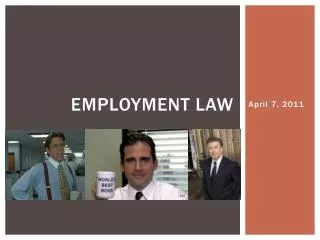
EMPLOYMENT LAW
EMPLOYMENT LAW. April 7, 2011. Overview of today. The American System: Employment “at will.” Employee rights to privacy in “at will” system. Term contracts and “just cause.” Some exceptions to “at will” employment. Controverting public policy Discrimination. Employment “at will”.
660 views • 44 slides

546 views • 38 slides

Employment Law. Jody Blanke, Professor Computer Information Systems and Law Mercer University, Atlanta. Employment Law. Primarily state law varies from state to state A good bit of federal law, too mostly discrimination law. At-Will Employment. Generally, an employee
643 views • 42 slides

EMPLOYMENT LAW. Mark A. Shank Gruber Hurst Johansen Hail & Shank, L.L.P. 1445 Ross Avenue Dallas, Texas 75202 214-855-6800. Gruber | Hurst | Johansen | Hail | Shank. The laws:. 1. Title VII. 2. Equal Pay Act. 3. Age Discrimination in Employment Act.
609 views • 45 slides
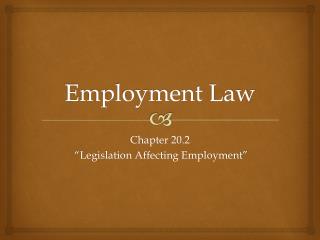
Employment Law. Chapter 20.2 “Legislation Affecting Employment”. Regulating Collective Bargaining. Government has played an active role in regulating collective bargaining In the past, courts held that collective bargaining to be an illegal conspiracy
165 views • 0 slides
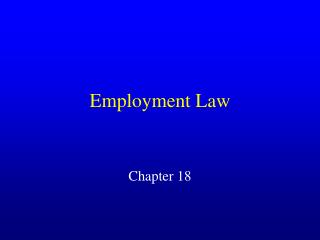
Employment Law. Chapter 18. Employment At Will. Common law doctrine under which either party may terminate employment relationship at any time for any reason (or no reason). Employment At Will. Exceptions in the case of: Employment contracts Public policy such as whistleblower protection.
593 views • 0 slides
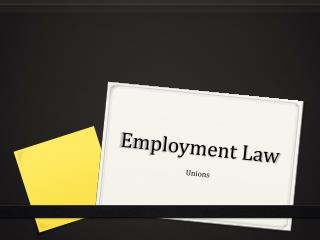
Employment Law. Unions. What is a labor union?. "a group of workers who have banded together to achieve common goals in the key areas of wages, hours, and working conditions" (Boone and Kurtz, 1999, p. 414) who become affiliated with a recognized union organization
161 views • 0 slides

EMPLOYMENT LAW. Overview of today. Describe the rights and responsibilities of employees and employers. Identify federal, state, and local laws and agencies dealing with employment. Identify the legal ground for employee termination. Employment “at will”.
400 views • 28 slides
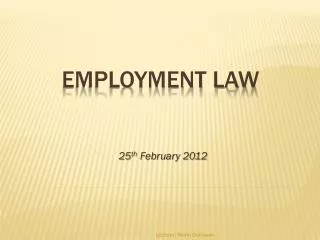
25 th February 2012. EMPLOYMENT LAW. The body of laws , administrative rulings, and precedents which address the legal rights of, and restrictions on, working people and their organisations. Mediates many aspects of the relationship between trade unions, employers and employees
859 views • 38 slides

Employment Law. Chapter 20.1 “Employment Relationships”. Employment-at-Will. The general rule governing employment in most states An employer is permitted to discharge an employee at any time, for any or no reason, with or without notice
487 views • 14 slides

EMPLOYMENT LAW. Mary-Jane Thomas, Partner Riki Donnelly, Solicitor. You Cow – I was going to say that. MOO. Recent Legislative Changes . Minimum Wage Increased by 25 cents to $13.75 Implications for salaried workers who are in danger of working too much Starting Out Wage
863 views • 67 slides

Employment Law. Coach Johnson Understanding Business and Personal Law. Section 20.1 . Employment Relationships. Employment Relationships. Employment at Will Fire/Quit at any time as long as: No express contracts involved No implied contract involved Ex: Walton County Policies Unions:
519 views • 25 slides

Employment Law. Jessica Neilson. Chapter 11: National Origin Discrimination. Reminder: How many employees are req’d for Title VII to apply?. 15. National origin discrimination: EEOC Guidelines. No discrimination on the basis of: EE’s place of origin (or her ancestor’s)
430 views • 25 slides

EMPLOYMENT LAW. Indicative Reading.
229 views • 14 slides

Employment Law. Week 8. Fair Labor Standards Act (FLSA. Regulated wages and hours • Guidelines on minimum wage Overtime - Child Labor. Exempt Non-exempt. Non exempt – need to be paid time and a half for any hours over 40 hours a week Exempt – are not required to be paid overtime
308 views • 12 slides
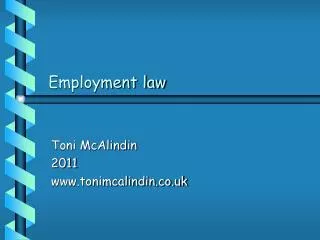

Employment law
Toni McAlindin 2011 www.tonimcalindin.co.uk. Employment law. Background. Employment law is relatively modern in relation to many other areas of law Most rights originated in the 70s
481 views • 27 slides

EMPLOYMENT LAW. WEEK 2 : CONTRACTUAL RELATIONSHIP BETWEEN EMPLOYER- EMPLOYEE. LEARNING OUTCOME. The students will be able to;. DEFINITION OF CONTRACT OF SERVICES.
343 views • 18 slides

EMPLOYMENT LAW. TITLE VII PREJUDICIAL TREATMENT DISPARATE TREATMENT DISPARATE (ADVERSE) IMPACT AFFIRMATIVE ACTION (11246). WVU MBA. EMPLOYMENT LAW (cont.). SEXUAL HARASSMENT EQUAL PAY ACT AGE DISCRIMINATION IN EMPLOYMENT ACT AMERICANS WITH DISABILITIES ACT. WVU MBA.
272 views • 13 slides

Employment Law. You Are Not Alone. You Are Not Alone. Regional HR Managers Handout 80/20 Rule…More like 90/10 Done well - 20% of your time Done not so well - 80% of your time Federal V State Laws The richer of the 2 prevails on behalf of the colleague. The Interview. Plan
386 views • 20 slides
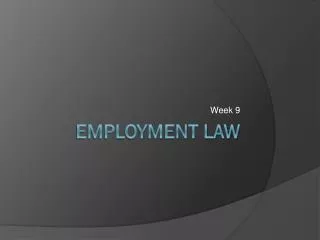
Week 9. Employment Law. Workplace Safety. The Occupational Safety and Health Act of 1970 (OSHA Act) set forth a standard that would provide for the safety and health of employees while on the job. Employers are required to provide a place of employment free from occupational hazards.
321 views • 19 slides

O’Connor, Parsons, Lane & Noble has the honor of being listed as a Best Law Firm in the United States by US News & World Report. That includes our individual attorneys who are recognized as Best Lawyers in America or as Super Lawyers or both, accomplishments about which we are very proud. Every partner on our team has successfully obtained multi-million dollar verdicts and settlements on behalf of plaintiffs in their respective areas of medical malpractice, personal injury and employment law. Our legal team is comprised of some of the best lawyers in New Jersey. As thought leaders and problem solvers, our work is informed by fairness, humanity and justice. Are we passionate about fighting for our clients? Count on it.
152 views • 12 slides

- My presentations
Auth with social network:
Download presentation
We think you have liked this presentation. If you wish to download it, please recommend it to your friends in any social system. Share buttons are a little bit lower. Thank you!
Presentation is loading. Please wait.
Labour & employment law
Published by Mildred Townsend Modified over 6 years ago
Similar presentations
Presentation on theme: "Labour & employment law"— Presentation transcript:
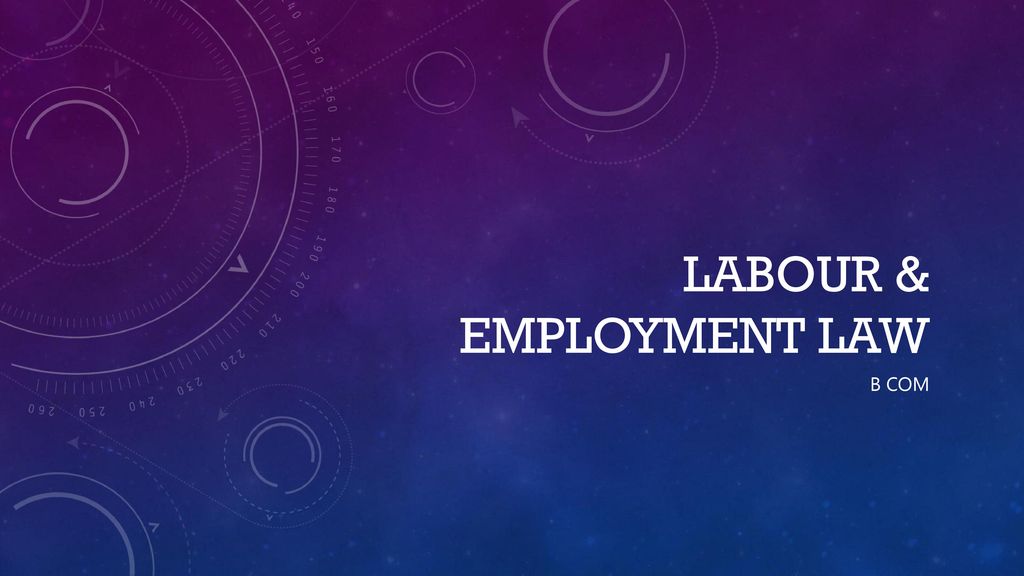
EMPLOYMENT CONTRACTS: WHAT IS IMPLIED AND WHAT IS NOT? RICHARD J. GILBORN, Q.C., April 30, 2004.

A contract of employment is a reciprocal contract in terms of which an employee places his services at the disposal of another person or organisation,

Employment law – rights and responsibilities Riverland Community Legal Service.

Theme 4 Common Law Contract of Employment

LECTURE 7. Only if it is agreed between the employer and employee. Agreement valid for 1 year. Overtime: ◦ Per day = no limit. Act however limit.

Discipline and Dismissals Lecture 15

LECTURE 4. See the study guide for paragraphs to be studied and those for reading purposes only Follow p21 of the study guide in this respect.

LABOUR LAW – ARR224 Lecture 5 The Basic Conditions of Employment Act, 75 of 1997.

Lecture Those rules regulating the legal relationship between: ◦ employees, ◦ employers, and also between employers and employees and the Sate,

CHAPTER 7 EMPLOYEE RELATIONS

“The process of regulating the relationship between the parties to the employment contract” Employment law.

The Collective Agreement for Supervisory Managers TEAM-IFPTE Local 161 September 19, 2012.

Chapter 8 Employment Laws. Employment Act Industrial Relations Act Trade Unions Act Trade Disputes Act Workmen’s Compensation Act Retirement Age Act Workplace.

1 introduction. 2 Introduction cont. The Four main labour laws 1.LRA -Act 66 of BCEA – Act 75 of EEA– Act 55 of Skills Development.

OCCUPATIONAL HEALTH AND SAFETY (2). The duties extend to; a) Their own employees b) Their independent contractors and their workers who may be working.

EMPLOYMENT LAW B COM HRM. UNIT OUTCOMES See page 149.

Basic Conditions of Employment - 57 of 1997 (67).

Discipline and Dismissals Lecture 12. Must be fair. RSA courts have decided that “Fairness” constitutes: 1.Substantive Fairness - Pertaining to reason;

Chapter 40 Labor and Employment Law. 2 What is the employment at will doctrine? When and why are exceptions made? What federal statutes govern working.

IGCSE®/O Level Economics
About project
© 2024 SlidePlayer.com Inc. All rights reserved.

IMAGES
VIDEO